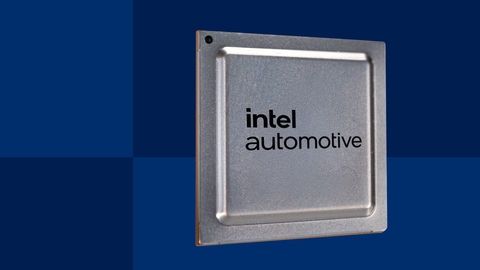Intel Accelerates Software-Defined Innovation with Whole-Vehicle Approach
Intel has unveiled at CES 2025 an expanded product portfolio and partnerships aimed at accelerating the transition to electric and software-defined vehicles (SDVs). The company introduced a comprehensive whole-vehicle platform that includes high-performance compute, discrete graphics, AI, power management, and zonal controller solutions.
A key announcement is the new Adaptive Control Unit (ACU), designed specifically for EV powertrains and zonal controller applications. The ACU U310 consolidates multiple real-time, safety-critical, and cybersecure functions into a single chip.
Intel has also partnered with AWS to co-develop the Intel® Automotive Virtual Design Environment (VDE). This integrated approach aims to reduce development costs and improve performance by optimizing the entire vehicle's electrical/electronic architecture, enabling automakers to build future mobility solutions more efficiently and profitably.
Intel ha presentato al CES 2025 un portafoglio prodotti ampliato e partnership con l'obiettivo di accelerare la transizione verso veicoli elettrici e veicoli definiti dal software (SDV). L'azienda ha introdotto una piattaforma integrata per l'intero veicolo che comprende soluzioni di calcolo ad alte prestazioni, grafica discreta, intelligenza artificiale, gestione energetica e controllori zonali.
Un annuncio chiave è la nuova Adaptive Control Unit (ACU), progettata specificamente per i gruppi motopropulsori elettrici e le applicazioni dei controllori zonali. L'ACU U310 consolida molteplici funzioni in tempo reale, critiche per la sicurezza e informaticamente sicure in un unico chip.
Intel ha anche collaborato con AWS per co-sviluppare l'Intel® Automotive Virtual Design Environment (VDE). Questo approccio integrato mira a ridurre i costi di sviluppo e migliorare le prestazioni ottimizzando l'intera architettura elettrica/elettronica del veicolo, consentendo ai costruttori di automobili di realizzare soluzioni di mobilità futura in modo più efficiente e redditizio.
Intel ha presentado en el CES 2025 una cartera de productos ampliada y asociaciones con el objetivo de acelerar la transición hacia vehículos eléctricos y vehículos definidos por software (SDV). La empresa introdujo una plataforma integral para todo el vehículo que incluye soluciones de computación de alto rendimiento, gráficos discretos, inteligencia artificial, gestión de energía y controladores zonales.
Un anuncio clave es la nueva Adaptive Control Unit (ACU), diseñada específicamente para trenes motrices eléctricos y aplicaciones de controladores zonales. La ACU U310 consolida múltiples funciones críticas para la seguridad, en tiempo real y ciberseguras en un solo chip.
Intel también se ha asociado con AWS para co-desarrollar el Intel® Automotive Virtual Design Environment (VDE). Este enfoque integrado tiene como objetivo reducir los costos de desarrollo y mejorar el rendimiento al optimizar toda la arquitectura eléctrica/electrónica del vehículo, permitiendo a los fabricantes de automóviles construir soluciones de movilidad futuras de manera más eficiente y rentable.
인텔읶� CES 2025에서 전기차 및 소프트웨어 정의 차량(SDV)으로의 전환을 가속화하기 위한 확장된 제품 포트폴리오 및 파트너십을 공개했습니다. 이 회사는 고성능 컴퓨팅, 개별 그래픽, 인공 지능, 전원 관리 및 존 컨트롤러 솔루션을 포함하는 전체 차량 플랫폼을 소개했습니다.
핵심 발표는 EV 전동기 및 존 컨트롤러 응용 프로그램을 위해 특별히 설계된 새로운 Adaptive Control Unit (ACU)입니다. ACU U310읶� 여러 개의 실시간, 안전-critical 및 사이버 보안 기능을 단일 칩으로 통합합니다.
인텔읶� AWS와 협력하여 Intel® Automotive Virtual Design Environment (VDE)를 공동 개발했습니다. 이 통합 접근 방식읶� 전체 차량의 전기/전자 아키텍처를 최적화하여 개발 비용을 줄이고 성능을 향상시키는 것을 목표로 하며, 자동차 제조업체가 미래의 이동수단 솔루션을 더 효율적이고 수익성 있게 구축할 수 있게 합니다.
Intel a dévoilé au CES 2025 un portefeuille de produits élargi et des partenariats visant à accélérer la transition vers des véhicules électriques et des véhicules définis par logiciel (SDV). L'entreprise a présenté une plateforme complète pour le véhicule entier qui inclut des solutions de calcul haute performance, des graphiques discrets, de l'IA, de la gestion de l'énergie et des contrôleurs zonaux.
Une annonce clé est la nouvelle Adaptive Control Unit (ACU), conçue spécifiquement pour les groupes motopropulseurs électriques et les applications de contrôleurs zonaux. L'ACU U310 regroupe plusieurs fonctions en temps réel, critiques pour la sécurité et cybersécurisées en une seule puce.
Intel a également noué un partenariat avec AWS pour co-développer l'Intel® Automotive Virtual Design Environment (VDE). Cette approche intégrée vise à réduire les coûts de développement et à améliorer les performances en optimisant l'architecture électrique/électronique complète du véhicule, permettant aux fabricants de véhicules de créer des solutions de mobilité futures de manière plus efficace et rentable.
Intel hat auf der CES 2025 ein erweitertes Produktportfolio und Partnerschaften vorgestellt, die darauf abzielen, den Übergang zu elektrischen und softwaredefinierten Fahrzeugen (SDVs) zu beschleunigen. Das Unternehmen stellte eine umfassende Plattform für das gesamte Fahrzeug vor, die leistungsstarke Rechenleistung, diskrete Grafiken, KI, Energiemanagement und zonale Steuerungslösungen umfasst.
Eine wichtige Ankündigung ist die neue Adaptive Control Unit (ACU), die speziell für elektrische Antriebsstränge und zonale Steuerungsanwendungen entwickelt wurde. Die ACU U310 konsolidiert mehrere Echtzeit-, sicherheitskritische und cybersichere Funktionen in einem einzigen Chip.
Intel hat ebenfalls eine Partnerschaft mit AWS geschlossen, um die Intel® Automotive Virtual Design Environment (VDE) gemeinsam zu entwickeln. Dieser integrierte Ansatz zielt darauf ab, die Entwicklungskosten zu senken und die Leistung zu verbessern, indem die gesamte elektrische/elektronische Architektur des Fahrzeugs optimiert wird, was es Automobilherstellern ermöglicht, zukünftige Mobilitätslösungen effizienter und profitabler zu erstellen.
- Introduction of new Adaptive Control Unit (ACU) consolidating multiple functions into single chip
- Strategic partnership with AWS for Virtual Design Environment
- Cost reduction through whole-vehicle platform optimization
- None.
Insights
At CES 2025, Intel unveils new adaptive control solution, next-gen discrete graphics and AWS virtual design environment.

At CES on Tuesday, Jan. 7, 2025, Intel introduced the availability of the Adaptive Control Unit (ACU), designed for electric vehicle (EV) power trains and zonal controller applications. The ACU U310 is a new kind of processing unit that supports the consolidation of multiple real-time, safety-critical and cybersecure functions, applications and domains (X-in-1) into a single chip. (Credit: Intel Corporation)
“Intel automotive is bringing innovative solutions that reduce cost in the SDV revolution. Our whole-vehicle approach, combined with cloud integration, delivers a complete solution that drives down total cost of development and deployment while empowering automakers to build the future of mobility faster, more efficiently and more profitably.”
-- Jack Weast, Intel Fellow, vice president and general manager of Intel Automotive
Why a Whole-Vehicle Platform Matters: Intel’s whole-vehicle platform reduces inefficiencies of traditional fragmented approaches to vehicle architectures. By optimizing the entire vehicle’s electrical/electronic architecture, Intel drives significant cost reductions and performance improvements.
Supporting this platform, Intel introduced the availability of the Adaptive Control Unit (ACU), designed for electric vehicle (EV) power trains and zonal controller applications.
About the Adaptive Control Unit: The ACU U310 is a new kind of processing unit that supports the consolidation of multiple real-time, safety-critical and cybersecure functions, applications and domains (X-in-1) into a single chip. Traditional time and sequential processing-based micro and zonal controllers struggle to handle multiple workloads due to limited deterministic processing capabilities. In contrast, Intel’s new family of ACU devices integrates a flexible logic area that offloads real-time control algorithms from the CPU cores, ensuring reliable performance, freedom from interference (FFI) and deterministic data delivery even when consolidating multiple microcontroller workloads into a single zonal MCU. This dual-brain approach enables greater workload consolidation, lowers cost, and enhances safety, cybersecurity and performance.
When used in an electric vehicle power train, the ACU U310 supports advanced algorithmic solutions that reduce vehicle energy demand from the battery, automatically adapting high voltage and control frequencies to individual driver styles and road conditions. The ACU reduces cost per kilowatt and enhances energy efficiency, allowing the vehicle to reclaim up to 40 percent of the power train system energy losses, delivering a
- Stellantis Motorsports selected Intel as a key technology partner and adopting the Adaptive Control technology into its next-generation inverter control for enhanced performance and efficiency in competitive racing environments. In this implementation, the Intel technology will control the electric motor and recover energy during braking phases. The inverter plays a crucial role during a Formula E race, where any gain in efficiency is transformed into a precious competitive advantage.
- Karma Automotive announced support for Intel’s ACU, showcasing an Intel co-branded inverter featuring Optimal Pulse Pattern control algorithms to improve efficiency and enable four unique driving profiles, including innovative features like Torque Ripple Reduction and Range Boost.
The ACU’s programmability allows it to serve as a first-of-its-kind software-defined zonal controller, adapting to different vehicle topologies and applications. This flexibility streamlines the transition to software-defined vehicles, simplifies supply chains and reduces the complexity of the vehicle BOM.
How Next-Gen Architecture is Enhanced with AI Inside: Building on Intel’s first-generation AI-enhanced SDV system-on-chips (SoCs), Intel announced the upcoming second-generation Intel® Arc™ B-series Graphics for Automotive set for production by the end of 2025. This solution provides the high-performance compute needed for more advanced in-vehicle AI workloads, next-generation human-machine interface (HMI) engines, and immersive in-vehicle experiences and AAA PC gaming. Paired with an Intel AI-enhanced SDV SoC, it delivers scalable performance for complex AI tasks, supported by the vast Intel AI ecosystem.
How Intel and AWS Revolutionize Automotive Software Development: Intel and AWS introduced the Intel Automotive Virtual Development Environment on AWS, a groundbreaking approach that ensures true hardware and software parity from cloud to car. This new offering addresses challenges throughout the vehicle development life cycle, enabling engineers to seamlessly switch between virtual and physical hardware setups. It integrates Intel® Xeon® processor-based Amazon EC2 instances and, for the first time, incorporates Intel’s Automotive SDV SoCs within the AWS environment, eliminating the need for expensive electronic control unit (ECU) simulators or developer boards. This collaboration provides a unified solution that accelerates innovation, reduces R&D costs and speeds time-to-market.
About Intel’s System-Level Advantage: Intel's whole-vehicle approach delivers numerous benefits to automakers, including cost reductions, enhanced vehicle performance, streamlined development, improved energy efficiency, seamless AI integration and faster time-to-market – all supported by Intel’s globally balanced supply chain.
More: | (Video)
About Intel
Intel (Nasdaq: INTC) is an industry leader, creating world-changing technology that enables global progress and enriches lives. Inspired by Moore’s Law, we continuously work to advance the design and manufacturing of semiconductors to help address our customers’ greatest challenges. By embedding intelligence in the cloud, network, edge and every kind of computing device, we unleash the potential of data to transform business and society for the better. To learn more about Intel’s innovations, go to and .
© Intel Corporation. Intel, the Intel logo, and other Intel marks are trademarks of Intel Corporation or its subsidiaries. Other names and brands may be claimed as the property of others.
View source version on businesswire.com:
Marcie Miller
1-480-319-4629
marcie.m.miller@intel.com
Source: Intel Corporation
FAQ
What new automotive technology did Intel (INTC) announce at CES 2025?
How will Intel's (INTC) new Adaptive Control Unit benefit electric vehicles?
What is the partnership between Intel (INTC) and AWS for automotive design?







